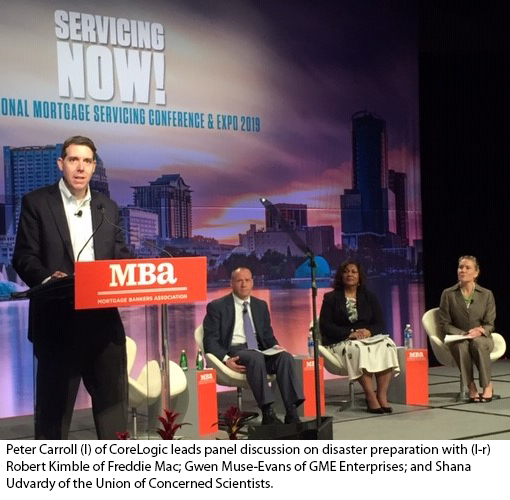
Preparing for ‘When,’ Not ‘If,’ in Natural Disasters
ORLANDO–Floods. Hurricanes. Earthquakes. Volcanic eruptions. Wildfires. Tornadoes. And that was just 2018.
CoreLogic, Irvine, Calif., recently noted that the U.S. has experienced more than two dozen “hundred-year” natural disaster in just the past three years.
Climate change is forcing the mortgage industry to rethink how risk is defined and assessed. And it’s not just natural disasters. Rising sea levels and spreading flood plains are threatening the long-term stability of the nation’s coastal communities. While economic losses due to rising sea levels are occurring gradually, their economic impact is expected to be far greater than anything experienced by the mortgage servicing industry in the housing crisis and the Great Recession.
 Shana Udvardy, Climate Resilience Analyst with the Union of Concerned Scientists, Cambridge, Mass., said a joint U.S./United Nations report showed that “climate change is here now.”
Shana Udvardy, Climate Resilience Analyst with the Union of Concerned Scientists, Cambridge, Mass., said a joint U.S./United Nations report showed that “climate change is here now.”
“Eighteen of the past 19 warmest years have occurred since 2001,” Udvardy said here at the MBA National Mortgage Servicing Conference & Expo. “Extreme heat posts grave risks for at-risk populations, including children and the elderly. And it is straining agriculture and causing crop losses.”
Climate change is causing stronger weather extremes, Udvardy noted. “The oceans absorb much of the heat, resulting in strong storms and storm surges,” she said.
These events are having a tremendous economic impact, Udvardy said, noting 20 disasters in 2018 alone that had a cost of more than $1 billion each, including Hurricane Michael, which caused more than $25 billion in damages.
UCS, working with Zillow Inc., estimated coastal communities will see increased and “chronic” flooding over the next decades, saying more than 300,000 homes with mortgages owed through 2045 at risk. “Chronic inundation will have significant economic and social impact on these communities,” she said. “It will also have indirect impact on other aspects of the economy, such as mortgage servicers.”
“When there are disasters, it affects a lot of decisions–such as whether to buy a home, or to rebuild or repair a home,” said. Gwen Muse-Evans, President and CEO of GME Enterprises, Chevy Chase, Md. “When you are dealing with families in crisis, the ones who are on ‘the border’ of recovery are at highest risk.”
Muse-Evans, former chief risk officer with Fannie Mae, said there are also secondary effects to disasters. “At the end of the day, there are families in crisis,” she said. “Having the awareness of the financial and emotional impact is important. And these families are also vulnerable to scam artists who can make the situation worse.”
Peter Carroll, Executive with Public Policy and Industry Relations with CoreLogic, said flooding and earthquakes represent the two largest disasters at risk of underinsurance–or no insurance.
“Flooding is not just a coastal problem,” Carroll said. “We’re seeing more inland flooding, so it’s become a national problem.” He noted while high-risk properties are required to have flood insurance, moderate and low-risk area properties are not, despite the fact that 20 percent of all National Flood Insurance Program claims are for properties that do not require flood insurance.
Robert Kimble, Vice President of Mortgage Servicing Policy with Freddie Mac, McLean, Va., said the company has revamped its disaster policies to anticipate disasters as well as respond to disasters. “Each new storm teaches us a bit more,” he said. “We have a ‘playbook’ that enables us to assist borrowers when a disaster occurs.
“Disaster preparation and response has to be part of your company’s strategic planning,” Muse-Evans said. “But the bigger picture is there needs to be more coordination across the industry and other players. We have to collaborate and share the knowledge in the event of an emergency.”
